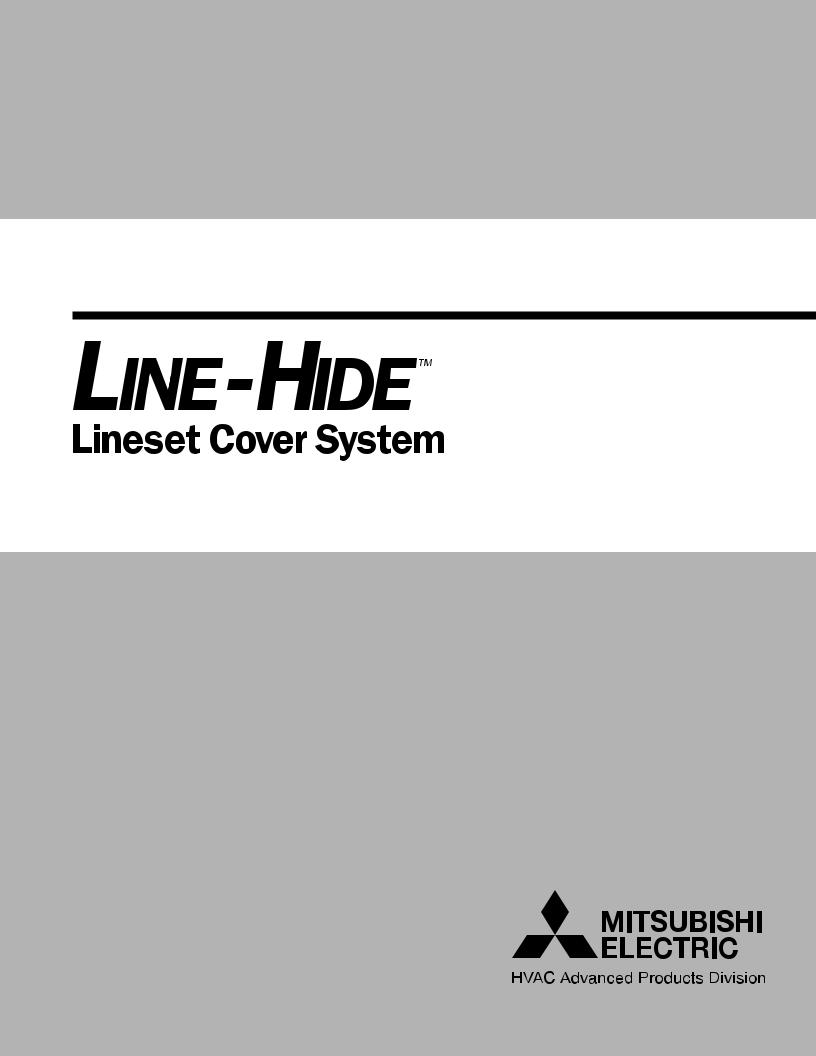Mitsubishi Electronics Line-Hide Installation Manual

Distributed by
MITSUBISHI ELECTRIC
WWW.LINE-HIDE.COM
No. LIOCA 100710M
INSTALLATION INSTRUCTIONS
Perfect for  and other A/C and plumbing applications and installations.
and other A/C and plumbing applications and installations.
PROTECT &BEAUTIFY

WARNING! Before you begin . . .
INSTALLATION INSTRUCTIONS
Whenever you’re working with tools, it’s a good idea  to wear appropriate safety gear: helmet, protective goggles, and gloves. If you’re working high above the ground, be sure that you have sound footing.
to wear appropriate safety gear: helmet, protective goggles, and gloves. If you’re working high above the ground, be sure that you have sound footing.
Installing Line-Hide
Your Line-Hide installation will go smoothly if you follow — in order — the steps outlined in these instructions: determine layout; install entry fittings and joint bases; install Line Tube base; insert Lineset: assemble tube, and assemble joints. When you’ve finished, caulk the lineset entry and exit points on the wall to ensure the protection of the Lineset and of the building.
Step 1: Layout
Identify the inlet and outlet points for the Lineset
you’ll be installing within the Line-Hide product, and determine the simplest and most appropriate route for the
installation to follow. In most cases you’ll want your installation to run perfectly vertical and nearly horizontal (a slight grade will enable condensate lines to drain) and adhere to 90 degree turns. Sketching your installation on a contractor worksheet or graph paper will help you to determine how much tubing and how many elbows, joints, and other pieces you will need.
Step 2: Install Entry Fittings and Joint Bases
Most Line-Hide entry fittings and joints (including elbows) include a base and a cover. Once you’ve determined where your joints will be, install the bases. If you’re installing on wood, simply position the base, and fasten it to the wall, using wood screws. Don’t overtighten, or you’ll risk cracking the plastic.
For installations on a brick wall, mark the location for each screw, and drill an anchor
using a masonry bit; then use appropriate anchors and screws.
Step 3: Install Line Tube Base
Measure the distance between the molded stops of each joint base, and determine the length of tube needed. Line-Hide Line Tube is manufactured in six-and-one-half-foot (two-meter) lengths so some straight runs are fabricated using two or more lengths of tube and a socket/coupling.
To cut tube, measure and the appropriate length; then draw a perpendicular guideline across the tube. Use a hacksaw to cut the tube along the line, and
then use a file to smooth the cut edge.
To attach the Line Tube base to the wall, first use the tip of a screwdriver to make a hole in the central rib of the base (thin spots
are moulded in to accommodate installation). Then put a screw through the hole in the tube, and tighten it to the wall. Be careful not to overtighten, for you may distort the tube. For the smaller sizes (the 60 and 75 series), place screws approximately every twelve inches. For the larger sizes (the 100 and 140 series), use screws approximately every six inches.
Step 4: Install the Lineset
Unwind insulated refrigerant lines, and place into straight portion of the tube. When installing insulated refrigerant pipe into a corner, adjust the pipe to the shape of the joint, and gently bend the insulated refrigerant pipe without forcing it. Bending too quickly can cause kinks in insulated refrigerant pipe and can pinch drain pipe. Also try to avoid compressing the pipe insulation.
A Saddle Band (NV-S short or NV-L long) can be used to fasten the insulated refrigerant pipe, drain pipe, and electric cable together in the Line Tube. The saddle snaps to the central rib of the tube base. Thread the band through the
saddle and around the piping and cable, and pull it tight. This procedure will help to keep the pipes and wiring in place.
As a general rule, use one saddle band for every three feet (one meter) of tube.
Step 5: Assemble the Line Tube
When the Lineset is in position, attach the tube cover to the base. Slip the lip on the short
edge of the cover into the trough on the high edge of the base. Then squeeze the short end of the base while pushing the long edge of the cover inward so that the lip and the trough engage.
Step 6: Assemble the Joints
With the Line Tube completely assembled, return to each joint, and complete assembly. Position the cover of each joint over its base; line up the holes; then secure cover to bases with the stainless steel screws provided.
LIOCA 10/07 10M |
©2007 Mitsubishi Electric and Electronics USA, Inc., HVAC |
